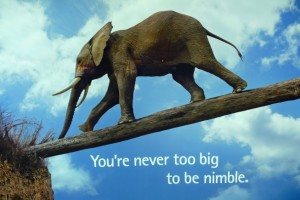The Power of Boutiques – Be Nimble, Be Quick
Published: May 25, 2016
In a presentation we recently gave at the 2016 IHRSA International Convention entitled, “The Power of Boutiques: Leveraging the Power in a Traditional Club Setting”, one of the powers we highlighted involved being nimble and quick.
The fitness industry finds itself immersed in the storms of creative destruction created by the 4th Industrial Revolution, and in particular by the Internet of Things. Today, because of technology and shifting generational values, what consumers want and what they use can change in a blink of an eye. Trends that used to take years to evolve and garner traction can now immerge quickly, and if your business doesn’t respond quickly, then any potential competitive advantage that could be gained by leveraging the trend may be lost. Consequently, today’s great businesses must be able to adapt like a chameleon if they want to stay ahead of the crowd. Jeremy Stoppelman, CEO of Yelp, said of this need to rapidly adapt, “You have to be very nimble and very open minded. Your success is going to be very dependent on how you adapt.”
Our work with boutiques has shown us that they, more than traditional fitness facilities, and especially those that operate multiple facilities, are significantly more nimble and quick in how they respond to and leverage consumer trends. So what does it take to be nimble and quick?
- Be open-minded; almost to a fault. Complacency and believing that what you have always done will continue to work going forward is the first barrier to nimbleness. Open-mindedness doesn’t mean you have to adapt, but it does mean you have to assess the landscape, determine if adaption is required, and then act quickly on your decision. As Albert Einstein so eloquently stated, “We cannot solve our problems with the same thinking we used when we created them.”
- Decide nimbly. The first challenge to acting nimbly is reaching a decision quickly and then committing your resources to acting on that decision. Nimble decision making may require creating a decision making process that allows you to use your experience (e.g., intuition) in combination with some hard facts. What it also means is cutting through the bureaucracy that often stagnates decision making. It is not about having unanimous agreement on the decision; instead it’s about quickly building consensus with the caveat that the leader should be able to override that consensus when it slows the process down.
- Act nimbly. In Silicon Valley they talk about failing fast. Others might say succeed fast. What would be more appropriate is to act quickly, assess quickly and then act accordingly, again quickly.
Great boutique fitness studios, due to many factors, have the ability to see the business climate more open mindedly that their larger more entrenched competitors, and furthermore, they have far fewer bureaucratic processes to deal with to make a decision and act on it. As Peter Drucker stated, “The enterprise that does not innovate inevitably ages and declines. And in a period of rapid change such as the present…the decline will be fast.” Rapid innovation is nothing more, but also nothing less, than being nimble and quick.
Tags: boutiques, change, fitness studios, nimble
